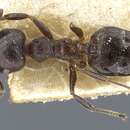en
names in breadcrumbs


Taxonomic history
Forel, 1916 PDF: 410 (q.).Combination in Crematogaster (Atopogyne): Wheeler, 1922: 857.Combination in Crematogaster (Crematogaster): Blaimer, 2012c PDF: 55.Raised to species: Wheeler, 1922: 857; Emery, 1922c PDF: 155; Santschi, 1935a PDF: 262.Plate XI, Figures 1 and 2; Plate XII, Figures 1 and 2; Plate Xlii, Figure 1
Medje, [[worker]]; Avakubi, [[worker]]; Stanleyville, [[worker]], [[queen]], [[male]] (Lang and Chapin).
According to Santschi (in litt.), "this form represents the extreme limit of the subgenus Atopogyne . The worker has a feeble groove on the postpetiole, and the premesonotal impression is feeble. Moreover, the female is brown, smooth, and shining, with spined epinotum, very different from the female of C. africana (Mayr) and the variety zeta (Forel)."
The specimens from Avakubi were collected by the natives, who call this ant "lona." The carton nests are shown in PlateXI and XII. Concerning the specimens from Stanleyville, Mr. Lang writes: "These small black ants are very common. They build carton nests in trees, on the trunks of which they travel up and down in uninterrupted columns. At the slightest disturbance the nest is covered with workers. They appear and move so rapidly that it is very difficult to study them, especially as they sting disagreeably. Large numbers of nests may be found in the same tree, sometimes as low as ten feet from the ground, or even in bushes as well as in the tops of the tallest trees, living or dead. They have almost any shape, depending on their position, whether in forks of the branches or about twigs. In the latter situations they resemble mere lumps. The more regular nests, however, are somewhat conical, like the tops of termite hills and are placed upright on the boughs. In color, the carton is grayish or dark brown. In size, the structures are rarely more than two feet in height and about a foot in diameter. Their cells are irregular, the walls of the chambers being from 1 to 3 mm. thick, and there are many entrances and exits. Though very light, the nests are so tough that slices can be chopped off with a hatchet without breaking the remainder. The carton seems to be made from the fibres of rotten leaves worked up with secretions from the oral glands of the workers. The chambers are> often full of brood, which is not confined to any particular part of the nest. The rufous females were present in such numbers that twenty or more could be lifted at a time clinging to one another on the points of the tweezers."